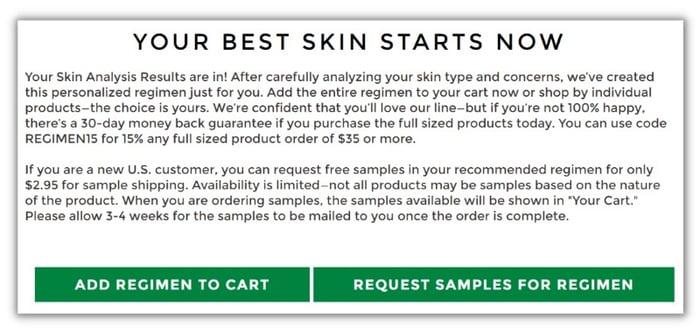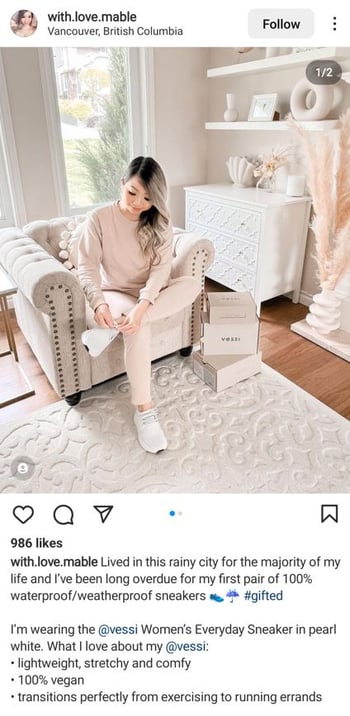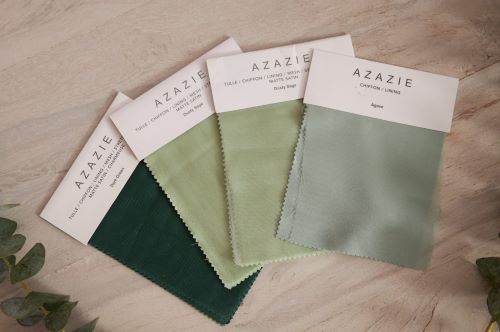7 Creative Product Sampling Ideas and Examples for Brands
Sampling is about more than sending freebies. These creative product sampling ideas illustrate how brands can go above and beyond to delight...
Product sampling is an old-school tactic that’s as effective as ever for brands today. Below we dig into why sampling campaigns work and how to get started.


Product sampling is a tried-and-tested marketing tactic for brands.
Heck, free samples have been working to win customers for over a century. Talk about old school!
The concept is simple: offer shoppers a taste of your products to put them on the path to purchase. Given that 74% of consumers want to try products before buying, samples make sense for most brands.
The catch? Modern product sampling campaigns are about more than freebies and coupons.
Done right, samples create a meaningful, memorable experience for customers on the fence. Goal-driven sampling builds awareness and attracts new business at the same time.
Curious about how to get started with product sampling yourself? Below we share examples, benefits and best practices that can help.
Skip to Section 👇5 Popular Types of Product Sampling Campaigns and Programs Why Product Sampling Marketing is So Effective for Brands |
Unlike in-store sampling (ex: Costco), most online brands can’t offer freebies on demand.
And so modern brands are getting more and more creative with how they handle samples.
The good news? No matter what you’re selling, there’s likely a method that fits your product.
Let’s kick things off by breaking down the most popular sampling methods. We’ll also show off a few product sampling ideas in action to highlight how brands are crushing it right now.
Direct mail sampling is straightforward. This type of program involves sending samples or trial products via mail. Shoppers will then eat a small shipping fee in exchange for their samples.
For example, Mario Badescu offers a personalized skincare quiz to first-time shoppers. Upon finishing, participants are presented with relevant products related to their unique regimen. Then, shoppers are given the option to buy products outright or request samples.

Source: Mario Badescu
Direct mail sampling programs are particularly popular among specialty beauty brands. Paying a few bucks for shipping is well worth it for shoppers mulling over a $100+ purchase. The higher your price point, the more likely shoppers will want to try before they buy.
This sampling method involves giving shoppers a digital taste of your products. In short, shoppers get to try products without leaving the house or ordering an in-home trial.
For fashion and apparel brands, virtual try-on using AR have grown more popular over the years. Check out Zenni Optical’s virtual try-on experience below.

Source: YouTube
While virtual product sampling is sort of niche, it is instant. This approach doesn’t require brands to ship physical products, either. For consumers, virtual sampling means no shipping fees or juggling packages.
The caveat? Virtual sampling doesn’t 100% reflect what you offer. That’s because people aren’t getting your products in their hands. Still, there’s no denying the convenience of virtual sampling for both parties.
Product gifting is a form of sampling where you send your products to content creators.
The “gift” here is simply a sample of your product. The sample is also a gift because it’s sent with no strings attached.
Of course, the goal is to get those creators to post about your brand on social media. If you want to attach those strings and require a post in exchange, be sure you’re establishing an equal value exchange with the creators involved.
For example, if you want them to create a TikTok video for you, don’t just send them a trial-sized, single-use eye cream. Post requirements mean you will need to gift more.
Below is a great product gifting example from Vessi:

Source: @with.love.mable
Gifting campaigns do double duty by helping brands win new customers and build social proof at the same time. That said, gifting requires some legwork. The process of contacting creators and sending them packages can be time-consuming.
The benefits are worth it if you have the bandwidth, though. From posts showing off your brand to glowing reviews, gifting is among the best product sampling methods for building awareness.
It’s no secret that consumers are more comfortable than ever shopping online.
Consider that convenience is the top driver of online purchases. Sampling offers a frictionless way to get your products into people’s hands faster.
Still, some products need to be seen in person before buyers are comfortable. As noted earlier, this is common with high-ticket purchases.
Warby Parker’s at-home try-on is probably the most popular example of in-home ecommerce sampling. More and more brands are experimenting with this method following Warby Parker’s success. Even Amazon is hopping on the sampling bandwagon with their Prime Try Before You Buy program.
Below is another example from Azazie. The brand offers try-on wedding dresses and free swatch samples for shoppers. Their dresses and gowns must be returned within seven days of being received. On the flip side, their swatches are truly free samples with no returns necessary.

Source: Azazie
This example highlights how brands can run multiple product sampling programs at once.
No surprises here! Free gifts at checkout are a staple of many CPG brands.
Ulta’s free gifts with purchase are a good example. As an added bonus, shoppers can actually choose which products they want to try.

Source: Ulta
This choose-your-own product approach is ideal versus offering one-size-fits-all samples.
By default, the products sampled will be more relevant to individual shoppers than random items. This increases the chances that shoppers will make a full-blown purchase in the future.
Samples are arguably one of the most time-tested marketing tactics. Like, ever.
But why are samples so effective today?

Source: Twitter
Good question! Let’s quickly review the benefits of product sampling for modern marketers.
Food for thought: 70% of consumers say it’s important for brands to provide personalized experiences
This is an ongoing trend and expectation among shoppers post-pandemic. As ecommerce grows, opportunities to build one-on-one connections with customers shrink.
And so brands that can create a unique experience for their customers have the most to gain.
Recommending and offering personalized samples is compelling to consumers. Random freebies are nice, but custom samples for individuals are ideal. Personalization means offering relevant products and making people feel like they’re being attended to.
Consider also that anyone that asks for (or accepts) a sample is high-intent. Most shoppers won’t go through the process of requesting samples unless they’re legitimately interested. Your product sampling program can serve as a way to identify relevant shoppers ASAP.
Sampling campaigns offer a goldmine of info for brands. Specifically, how to fine-tune your marketing strategy. Here’s a quick snapshot of what you can ask and answer through consistent sampling:
For example, product samples that never get claimed or talked about might be worth phasing out. On the flip side, your popular samples can highlight what people like the most about your brand. You’ll never know these insights until you get your products into people’s hands, though.
Samples can serve as mini focus groups to uncover your products’ strengths and weaknesses.
This illustrates yet another benefit of influencer gifting. When creators post about your product, you can earn authentic and unfiltered feedback. Note which products and qualities (ex: materials, ingredients, features) they shout out. Then, emphasize those strengths in your future marketing campaigns.

Source: @melissaamaakeup
Have you ever had a feeling of obligation when somebody gives you something you weren’t expecting?
That feeling comes from a cognitive bias known as reciprocity.
Without getting too scientific, reciprocity occurs when a brand gives a consumer a free sample.
The use of reciprocity in marketing is well-documented. Think about how Costco has made sampling such an important part of the shopping experience for members. Conventional wisdom says that people who try products are far more likely to buy them than people who don’t.
Well, product sampling campaigns online have the same effect. When you mail out a sample of your product, you trigger the reciprocity effect. This increases the chances that recipients become buyers.
When you offer an in-person sample, people only get a narrow and limited understanding of your product.
For example, a customer might try a perfume sample in the store. Thing is, that customer won’t know how well the perfume lasts after a day of work.
When you offer an in-home sample, people get a chance to use your product as they would if they bought it. This creates a much-needed sense of reassurance.
Also, consider how some product sampling campaigns offer a taste of your checkout experience. This is another way to get new customers familiar with your brand and products. The more time people get to spend engaging with your brand, the more comfortable they are with you.
If nothing else, social media product sampling is a brilliant way to get more user-generated content. This includes customer photos and videos, reviews and more.

Source: @lewendyy
Real-life product reviews and visual content are among the most important factors that drive purchase intent. You can earn both at the same time by offering samples.
Sampling is fair game for businesses of all shapes and sizes.
Whether you can realistically build your own program depends on a few key factors, though. On a high level, brainstorm whether or not your brand has the following:
Note: for companies with limited resources but time to spare, small-scale gifting campaigns are an option. The process of engaging with creators one-on-one to send products is still time-consuming. Still, this method is more manageable than trying to ship out dozens or hundreds of samples at once.
So, what does it take to actually do product sampling?
Sampling should be treated like any other marketing tactic. That is, brands should be methodical and understand what they’re getting into before kicking off a campaign.
Without getting too much into the nitty-gritty, below is a quick rundown of what needs to be done:
Note: we’ve covered many of these same steps in our influencer product gifting 101 post if you want more details on the processes above.
Offering samples of your products is a proven way to engage interested buyers and build brand loyalty.
Anything you can do to make a strong first impression on shoppers is a plus. Product sampling campaigns offer a unique opportunity to create an experience and highlight your product’s positives.
Combined with strategies like influencer marketing, brands can cover more ground and introduce their products to relevant audiences at scale.
If you're struggling to maximize your influencer marketing strategy in-house, Statusphere can help.
Our micro-influencer software matches brands with vetted influencers from our creator community using 250+ first-party data points. Unlike other platforms, we help brands earn guaranteed content.
Statusphere also eliminates the most time-consuming pieces of working with influencers in-house thanks to our advanced matchmaking and fulfillment technology.

We’ve already generated 75,000+ pieces of content for 400+ consumer brands.
Want to see how our platform works? Get in touch with one of our experts to learn how we can optimize your brand’s influencer marketing with guaranteed content at scale.
This article was first published in July 2017. It was last updated March 20, 2023.
Sampling is about more than sending freebies. These creative product sampling ideas illustrate how brands can go above and beyond to delight...
Traditional product sampling during COVID can be a little tricky. Here are 8 virtual product sampling ideas broken up by industry to try instead!
There are many different avenues you can take as a brand, but have you considered how a product sampling program can supplement your marketing...
Be the first to know about the latest tools, trends and strategies in influencer marketing for brands.